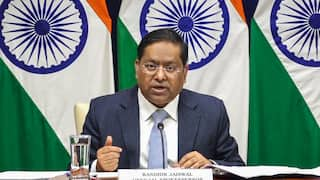In A First, Govt's Spending On Health Exceeds Out-Of-Pocket Spending. Here's What It Means
While the government health expenditure increased from 28.6 per cent to 48.0 per cent between 2013-14 to 2021-22, the out-of-pocket expenditure dipped from 64.2 per cent to 39.4 per cent.

The government's investment in the health sector has significantly reduced the out-of-pocket expenditures (OOPE) of Indian households in recent years, a government report has said.
In the past decades, the out-of-pocket expenditures in health have pushed 3-7 per cent of Indian households below the poverty line every year, with rural and poorer states facing a higher impact.
However, the latest National Health Account (NHA) study for 2021-22, shows dramatic changes in health financing parameters in the last decade, a report by Observer Research Foundation said on Monday.
As per the data, the government health expenditure increased from 28.6 per cent to 48.0 per cent between 2013-14 to 2021-22. Meanwhile, the out-of-pocket expenditure dipped from 64.2 per cent to 39.4 per cent.
ALSO READ | Paracetamol, Pan-D Among 53 Top-Selling Drugs Fail Quality Test By Indian Regulator
"The latest NHA estimates, available for 2021-22, show dramatic changes in health financing parameters in the last decade. Between 2013-14 and 2021-22 (Figure 1), a sharp decline of OOPE in health is observed, from 64.2 percent in 2013-14 to 39.4 percent in 2021-22, the year for which the latest data was released by the government," the ORF study said.
My analysis of the two recent National Health Accounts (NHA) reports published by @MoHFW_INDIA if finally out:
— Oommen C. Kurian (@oommen) September 30, 2024
National Health Accounts: Public spending finally overtakes out-of-pocket spendinghttps://t.co/KjAJh8zB5O @orfonline pic.twitter.com/zNzVapJuwa
"During the same period, the Government Health Expenditure (GHE) increased sharply from 28.6 per cent to 48.0 per cent. The proportion of GHE overtaking the OOPE component is a historic moment for India’s health policy, many years in the making," it added.
How Government Spending Helps Individual Families
The public health spending started rising from Rs 465 in 2004-5 to Rs 2,018 in 2021-22. Meanwhile, the rise in the government's investment led to a minor surge in out-of-pocket expenditures from Rs 1,434 to Rs 1,675 in the same period.
"Over the years, from 2004-05 to 2021-22, there is a considerable increase in public health spending, rising from INR 465 per capita in 2004-05 to INR 2018 per capita in 2021-22, indicating a strengthening of government investment in health, primarily driven by economic growth expanding the resources available for the sector, and the pandemic necessitating augmented allocations," the report said.
However, the out-of-pocket expenditures peaked in 2015-16 at Rs 2,063 per capita and then showed a gradual decline, settling at Rs 1,657 in 2021-22.
"The gap between per capita OOPE and GHE narrowed over time, till 2021-22 when per capita GHE overtook OOPE, reflecting government efforts to reduce the financial burden on individuals," the report added.
Centre's Investment Rising In Health
The ORF study stated that about two-thirds of overall Government Health Expenditure has been borne by the states and one-third by the centre.
However, the gap between the state and the centre is lessening with the centre's share rising to 41.8 per cent from 34 per cent in 2021-22 and the state's share decreasing to 58 per cent from 66 in the last decade.
Though the centre's spending was increased during the pandemic, the composition changed only by a slight margin. However, after the Covid-19 pandemic, the actual allocations by the Centre has not gone down to pre-pandemic levels, suggesting "the possibility of further reductions in OOPE in the future driven by government action."
"Both state governments as well as the union government will need to make sure that health spending does not slip back to pre-pandemic levels for India to have any real chance of achieving the national target of reaching 2.5 percent of GDP worth of government expenditure in health by 2025," the study said.






































